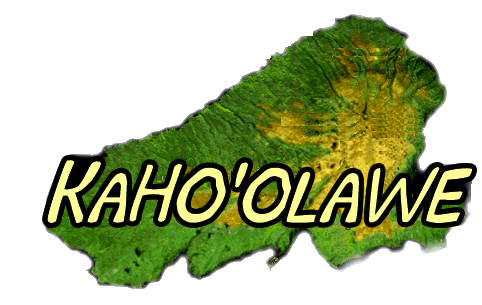
Home
Introduction to Kaho'olawe
PowerPoint
Introduction
Kaho'olawe Surveyor Software
Development Team
Role Cards
Key Elements for Reinhabiting
the Island
Presentation
Assessment
Related readings:
|
HISTORY HISTORY Ancient chants and archaeological evidence indicate Kaho`olawe was inhabited for over a thousand years. Hawaiians fished, farmed, and lived in coastal and interior settlement across the entire island. Called in ancient times, "Kanaloa" or "Kohemalamalama," the island was a place where kahuna and navigators were trained and played an important role in early Pacific migrations. Named for the god of the ocean and the foundations of the earth, Kaho`olawe is a sacred island that in modern times has served as the foundation for the revitalization of Hawaiian cultural practices. Initial settlement occurred around 1000 AD, approximately 400 years later than the other, larger islands. The island was originally settled along the coast, and later moved to the interior of the island. The island reached its maximum population of 525 around 1500 AD. By about 1650, a large settlement was formed at Hakioawa, on the island's eastern coast. The island's largest heiau is located here. By the end of the 18th century, internal strife, disease, introduced by traders and whalers, and emigration to the larger islands reduced the population of the island to about 160 in 1805. By 1840, part of the island was in use as a penal colony; by 1853, however, all exiles on the island were pardoned. Various ranching and agricultural efforts were undertaken in the latter part of the 19th century and into the early 1900s. Most of these could be characterized as marginally successful or unsuccessful, as overgrazing and erosion became significant. Kaho`olawe first encountered the US. military in 1841 when crews from two small vessels were shipwrecked and marooned on the island. By the 1920s, the US military had begun using Kaho`olawe for bombing practice, and, in 1939, the southern tip of Kaho`olawe was provided to the Army for use as an artillery range. In December 1941, the lease was canceled, and the island was used for Navy bombing and gunnery training. In 1953, President Eisenhower promised that the US. government would return the island to the people of Hawaii when its usefulness for military training was ended. In June 1965, the military detonated the largest non-nuclear explosion of its time on Kaho`olawe near Hanakanaia. The explosives consisted of 500 tons of TNT. The project was dubbed Project Sailor's Hat and resulted in this crater more that 50 meters in diameter. The resulting explosion created an anchialine pool which is a land-locked body of water with no surface connection to the ocean yet shows measurable salinity and tidal fluctuations in water level. Sailor's Hat is now a habitat for `opae`ula shrimp, snails and red tube worms. |
